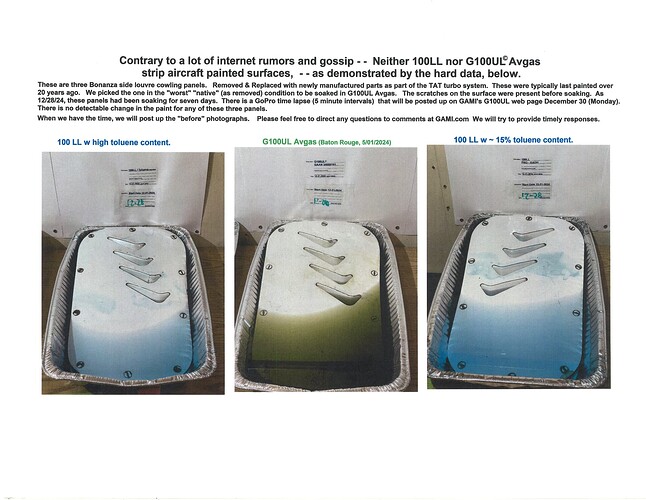Steve,
The FAA required us to conduct an extensive “functional” test of O-rings, gaskets, three different generations of fuel bladders, operating continental and Lycoming fuel pumps, fuel selectors, fuel spiders, carbs, and other engine related fuel wetted components.
That was one of the first “material compatibility” issues we addressed. That test was extended over a period of eight months. That was done with a “rig test.”
The FAA personally witnessed that operational testing at repeated intervals during the test run. All of the data and operating fuel temperatures were logged in real time. The FAA sent their senior engineers to GAMI to evaluate all of the components at the conclusion of the testing.
The FAA approved the results of that testing, without any exceptions.
That data was all presented to the ASTM about 9 years ago. The PAFI representative present at that ASTM meeting liked the rig test and asked if PAFI could have the test plan in order to incorporate that model into some of their testing. We provided them the test plan and the design of the rig-up modules used for the functional “rig-test.”
We have offered both Lycoming and Continental the opportunity to review that data. They have each declined to avail themselves of that good faith opportunity.
Over a decade ago, we sent several drums of G100UL Avgas to Continental at their request for testing. Two years later, they reported that they had not “had time” to do any testing. We had them send the drums back so we could do some long term storage stability analysis, which was nominal in its results.
We offered fuel to Lycoming for Lycoming to test. Lycoming wanted to charge us a large five figure sum of $$$ to conduct that testing. Since we have a significantly more capable engine test facility than does Lycoming (or Continental) we declined Lycoming’s peculiar offer.
Recently, we asked Textron to send one of their turbocharged Cessna on the long 50 minute trip from Wichita down to GAMI to let us fill the tanks with G100UL Avgas and work with Cessna for them to conduct a thorough evaluation of G100UL Avgas.
Cessna declined to avail itself of that opportunity.
I would extend an invitation to any legitimate group of California pilots to send a “delegation” to GAMI to review the complete FAA approved certification file, and observe, in person, some of the means and methods (including engine test stand runs) by which we conducted the certification of G100UL Avgas.
No other fuel candidate sponsor has been anywhere nearly as transparent and open about the testing and the results as has been GAMI.
I would note that the recent attacks (by major OEM industry participants) on the thoroughness and comprehensive testing and evaluation of G100UL conducted by the FAA could be interpreted by any number of conscientious FAA engineers and managers as a direct and unfounded attack on their competency.
Regards,
George Braly
Head of Engineering
GAMI
